SEO Optimization Demystified for Small Business Owners
Content optimization is crucial for small business owners. Why? Because your brand isn’t as well-known as the giants. But you have much to offer, and many consumers are tired of the monopolies. They want to support small businesses. Your goal is to help those people find you. (And, hopefully, buy your products and services.)
For brands like Amazon or Target, people already know what to search for. How can they find your business if they haven’t heard of it? The solution is SEO — the art of targeting organic traffic by ranking in web search results.
Every SMB has heard the term “SEO.” But many don’t understand what it is or how to use it to their advantage. SEO optimization may feel like an elusive, complicated undertaking — or something only an expert can achieve.
Thankfully, this isn’t the case. Anyone can optimize their content for SEO. Today, I’m going to show you how.
Jump ahead:
- What is SEO?
- Keyword Research
- Writing SEO-Optimized Content
- Helpful Tools for SEO Optimization
- Iterate Your SEO Optimization Strategies
What is SEO?
SEO — search engine optimization — means increasing your website’s visibility in search engine results. Remember the last time you searched the web? Did you even bother moving beyond the first or second results page? Probably not. Only the most optimized pages rank highly in search results.
The goal of SEO is to enhance the site’s relevance and authority in the eyes of search engines, making it more likely to rank higher for specific keywords or queries. This involves optimizing content and other elements.
Where To Start With Content Optimization: Keyword Research
Step one is the discovery phase. You need to understand what your target audience wants. What products or services are they shopping for? What questions are they asking? What do they enjoy learning about? Keyword research reveals the answers — and provides a wealth of topics for your blog.
Brainstorm Ideas
Start by brainstorming content ideas relevant to your brand. What topics would your customers be interested in? For example, if you own a small eCommerce business selling handmade clothing, topics might include:
- Sales and promotions
- Sewing guides
- Why handmade clothes are more ethical
- What do your clothes say about you?
- Tips for finding your size and ideal style
These aren’t your keywords, just a starting point. If you’re struggling with ideas, ChatGPT is a helpful resource.
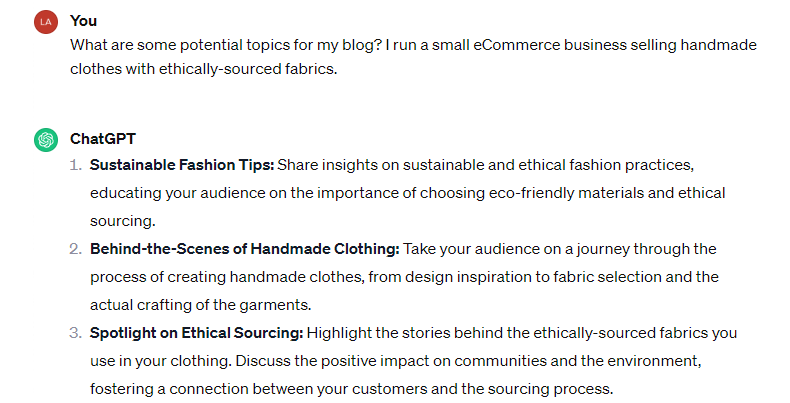
Later, you can narrow down which topics are popular among people who search the web.
Research Your Competitors
It’s wise to see what your competitors cover on their blogs, too. For example, if many similar businesses write about “Clothing trends in 2023,” that’s a smart topic to explore. Of course, you’ll want to add a unique angle to add value. Generic content doesn’t rank well.
Also, remember the topics must be relevant to your brand. After all, the end game isn’t just to rank — but to use those rankings to convert customers.
Consult Google
Now, let’s move on to the king of search engines: Google. Google has several features to help your keyword research. The first is Google autocomplete predictions. Start typing a topic into the search bar, but don’t press enter — wait for the list of auto-populated search queries.

Autocomplete suggestions are based on actual web searches, so they’re a fantastic way to explore popular topics of interest. Just remember to open your browser in Incognito Mode so your previous searches don’t impact the autocomplete suggestions.
Other helpful Google features are People Also Ask and Related Searches. You’ll see these sections on the first page of every Google search. They provide questions and queries related to your original search. Like autocomplete, these insights are based on real questions by Google users. They can help you determine the questions to answer in your blog posts.
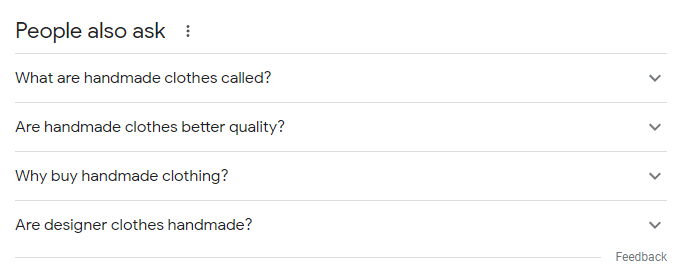
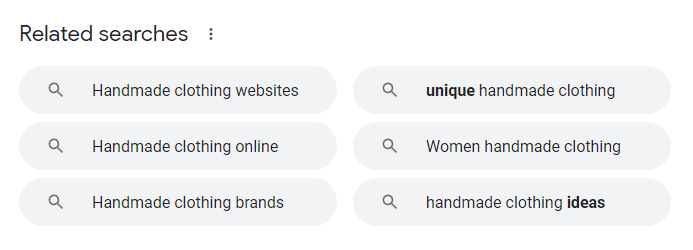
Lastly, explore the first page of results for your queries. Take note of common trends — not just topics, but how people phrase their page titles. If you notice a lot of listicles, pay attention to the numbers. If most listicles about clothing trends feature 15-20 insights, you’ll want to target a number in that range when writing your article.
AnswerThePublic
AnswerThePublic is another handy resource for uncovering related searches. It delivers related phrases and questions based on your seed keyword. AnswerThePublic is a “social listening tool.” It draws data from search engines and provides relevant, related questions. The tool organizes the data according to starter words like “what,” “which,” “can,” and “are.”
Reddit Discussions
Reddit forums are a goldmine for topic ideas. Subreddits related to your small business provide an insider’s look into what consumers are discussing. Look for common questions — areas where your content could offer solutions and add value. Also, pay attention to how people talk about relevant topics so you can infuse that language into your blog posts.
Keyword Data
By this point, you should have a good idea of what your target audience is searching for and a list of keywords to target in your content. You can begin writing content with those keywords, but your SEO results may vary. Keyword tools like SEMRush, Ahrefs, and Moz take the guesswork out of keyword research by providing real-time insights.
These tools offer limited free searches, but if SEO optimization is a big priority for you, their paid plans are worth the investment. You’ll have access to more insights and queries.
Enter some keywords in your tool of choice to analyze search volume, keyword difficulty, and other insights.

It’s vital to strike a balance between volume and difficulty. A high difficulty score means those terms will be hard to rank for, even if their volume is high. If you’re new to SEO optimization and don’t have an established web reputation, it’s best to start with lower-volume terms — there’s less competition, so you have a better chance of capturing those searches.


Writing SEO-Optimized Content
Let’s put your research and insights to good use. Writing SEO-optimized content includes using your target keyword, but there are other considerations. Many brands try to rank for the same web queries, so the competition is fierce. Your articles should be engaging and high-quality — but what does that really mean?
E-E-A-T
E-E-A-T stands for Experience, Expertise, Authoritativeness, and Trustworthiness. It’s a standard created by Google to measure the quality of search results. While E-E-A-T is not an official SEO metric, following these principles along with SEO best practices ensures your content is valuable and relevant to web searches.
Experience
High-quality content (including any claims or advice) is guided by personal experience. Has the content writer worked with the business? Has the influencer actually tried the product or service? You get the idea.
As a small business owner, you’re uniquely positioned to talk about your first-hand experiences, so put that to good use. Instead of being generic, include details about how you go about your daily work. It’s also helpful to include customer reviews on your website for non-biased user experiences.
Expertise
Your content should also demonstrate that you have the expertise to speak about and advise upon your subject matter. This is more straightforward in sectors like healthcare, legal, or finance — also called “Your Money or Your Life” (YMYL) categories — where experts can provide their credentials.
In other niches — like eCommerce for handmade clothing — you need to get more creative to prove your expertise. For example, documenting a detailed sewing project with before, in-progress, and after photos.
Authoritativeness
Authoritativeness is about how businesses and consumers perceive your brand. Are you considered an authority in your industry? Authoritativeness takes time to establish. The first goal is building a library of content around your niche, allowing search engines to understanding the context of your expertise.
As you publish more high-quality content, the second goal is earning backlinks from other websites. (For example, a blog from a related brand linking to your how-to sewing guides.) Moz offers a comprehensive overview of link building and earning backlinks, but the foundational step is publishing quality content that’s worthy of a link.
Trustworthiness
Lastly, it’s vital to demonstrate that your site is trustworthy. This metric includes a few different factors, from honesty and accuracy to accessibility:
- Thoroughly fact-check every article
- Cite reputable sources
- Use secure payment gateways
- Make relevant policies accessible to consumers (including privacy and return policies)
- Provide factual data about your brand (like location and contact information)
- Give an honest representation of user reviews
- Be up front about partnerships and advertising deals
When readers trust your brand, they’re more likely to visit your site, read your content, and buy products.
Stay Relevant
Relevant content ranks. Each piece should align with a user’s search intent — not just the words in the key phrase. Consider these example search queries:
- Where to buy handmade clothes
- A guide to creating handmade clothes
Though these searches use the keyword “handmade clothes,” their search intent is very different. It’s essential to remember this as you write, ensuring your content meets your audience’s needs.
Google also rewards writers who use related keyphrases. Instead of repeating the keyword over and over, make a list of similar terms to use throughout the piece. This tactic helps search engines understand the article’s context.
Be Comprehensive
TikTok may have shortened our attention spans, but long-form content rules the game in SEO. Research shows the highest-ranking posts are usually between 2,250 to 2,500 words. Longer, more comprehensive articles are generally more helpful to readers. There’s more time to dig into the topic, educate, inform, and inspire. It’s harder to establish authority in 300 words than in 2,500.
But don’t add unnecessary content to beef up your word count. Fewer, higher-quality words are better than fluff.
Ensure Readability
Even if your post is long, it should still be easy to read and skim. Write short sentences and include line breaks within the text. Otherwise, a long article can feel overwhelming to readers. Images and other media also add value and address all learning styles.
Optimize On-Page Elements
Besides the content itself, there are other on-page elements to optimize. These include the title, meta description, and headers.
Your content title should be no more than 60 characters and accurately describe the post. It’s best to keep your keyword close to the beginning.
A meta description summarizes your post’s contents and appears below the title in search results. Include your target keyword, and stay between 155-160 characters.

Headers are another crucial aspect of SEO, and they help with readability. The H1 tag is the title — the primary topic. Subsequent header tags like H2, H3, H4, and so on break the content into logical sections and subsections, providing a clear outline and hierarchy. This structure helps search engines understand the content and improves user experience by making the text more scannable.

As a general rule, include a sub-heading every 200-300 words. Incorporate your keywords into subheadings whenever possible.
Include Alt Descriptions
Alt descriptions summarize the images and other media included in your content. Alt text is vital for both SEO and accessibility. Screen-reading software reads alt descriptions aloud for visually impaired site visitors. This text is also displayed if the media doesn’t load, and it helps search engines understand your content.

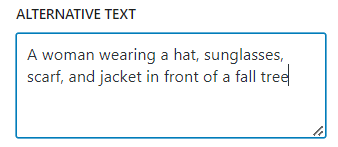
Post Regularly
Once you know the keys to optimizing your content, rinse and repeat. Regularly posting new blogs is one of the fundamentals of SEO. Search engines prioritize fresh content, as this is a sign of relevance.
New content also prompts search engines to crawl and index your site repeatedly, which helps it rank in real-time. Plus, the more you post, the more keywords you can target and the wider your audience becomes.
Many small business owners don’t have much time to sit down and write. As you’ll see in the next section, you don’t have to worry too much about that.
Helpful Tools for SEO Optimization
SEO strategy takes time, but there are tools to help you streamline the process, including writing and on-page optimization.
Quillbee
Quillbee is an AI writing partner that streamlines SEO-optimized content creation, saving you hours of manual effort. Instead of writing 2,500 words from scratch, use Quillbee’s Point of View feature to describe your topic in around 300 words. Put some thought into your prompt to ensure the best results. Include your target keyword, and it’s helpful to structure your Point of View into a logical beginning, middle, and end.
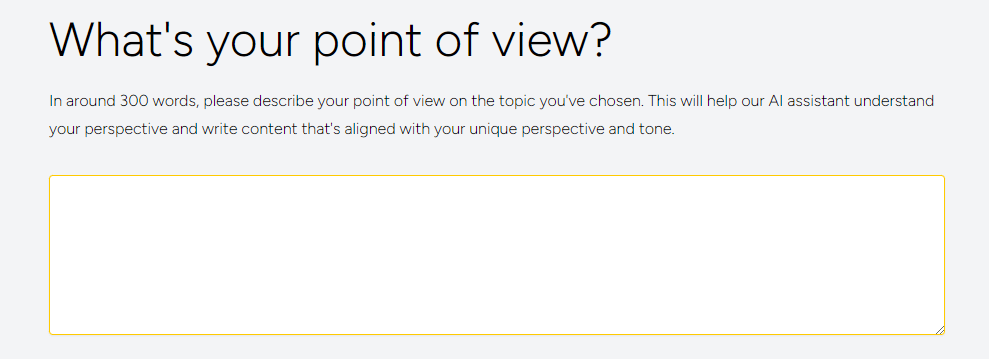
Next, Quillbee ushers you to the Content Brief. The brief includes four fields: keyword, topic, tone words, and perspective pronoun. These fields will auto-populate based on your Point of View, but you can update them. (For example, if the target keyword isn’t accurate or you prefer a different tone of voice.)
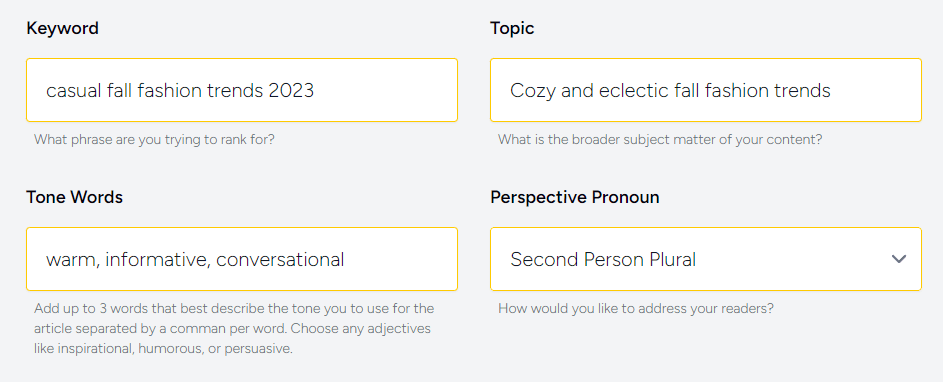
Quillbee generates an outline for your review. Make any desired changes, and then click “Generate Content.” You now have a fully-fleshed rough draft — written in a fraction of the time.
Of course, you should always thoroughly proof the content. Quillbee simplifies editing, too. Highlight a word or phrase to see options like “Rewrite,” “Expound,” or “Condense.”
You’ll have to do some optimization, like writing the meta description and alt text, in your content management system (CMS). (If you use Quillbee’s Pro plan or higher, you can export your content directly to WordPress.)
Yoast
Yoast is another must-have tool for optimization. The Yoast plugin works directly in your WordPress dashboard, tracking your content to help you follow best SEO practices.
Yoast scans your keyword usage, headings, meta description, alt text, and more. If things aren’t up to snuff, you’ll know right away. Once you’ve met all the SEO standards, Yoast gives you the “green light” to post. It’s a fantastic safety net, especially when you’re still learning the ropes.
Plus, Yoast also offers training and supplemental resources on SEO strategy, helping you dive deeper into a topic that’s vital for all small business owners.
Iterate Your SEO Optimization Strategies
SEO success is an iterative process. If you’re like me, you’ll learn more every time you research, write, and post. Use Google Search Console — an excellent tool for tracking your progress. You can monitor your site’s pages to see their performance, allowing you to update content and improve rankings. Slowly but surely, you’ll start to garner clicks — and attract more customers to your small business.
Hopefully, this article successfully demystified SEO optimization. Follow the tips and practices I’ve explored above so your content gets the attention it deserves.







